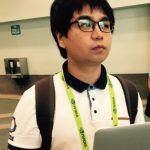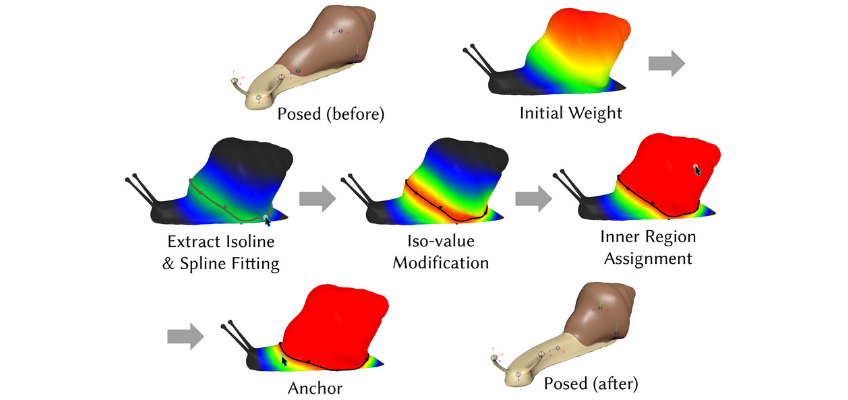Image created by Seungbae Bang, Sung-Hee Lee
Each year, the ACM Student Research Competition (SRC) — sponsored by Microsoft — is presented at well-known ACM-sponsored and co-sponsored conferences before a panel of judges and attendees, with the aim of awarding first-, second-, and third-place honors to both undergraduate and graduate research projects. The North American SIGGRAPH conference is no exception.
We caught up with SIGGRAPH 2018 first-place graduate winner Seungbae Bang to learn about his project and his experience both at and since last year’s conference.
SIGGRAPH: What was your reaction when you found out you won the ACM Student Research Competition?
Seungbae Bang (SB): I remember the beginning of SIGGRAPH 2018 was frustrating. I booked a flight ticket from Korea to Canada via China. Unfortunately, the flight from Korea to China was delayed so much that I missed the flight from China to Canada. I was able to get on the plane later, but my baggage was not delivered. I had all my stuff in that baggage, including the Poster. I had to reprint the Poster in front of the conference center. I also had another presentation for Thesis Fast Forward the same day for the Poster presentation. So, for the first few days of SIGGRAPH 2018, I was out of my mind. When they announced me for the first-place winner in Student Research Competition, I felt all that frustration and those hardships were finally rewarded.
SIGGRAPH: Tell us a bit about the winning project you submitted. What is innovative about it?
SB: My research “Computation of Skinning Weight Using Spline Interface” introduces a new spline interface for defining a skinning weight for character deformation. I am not a good rigging artist, but I had a little experience on rigging. And I found it very difficult to use conventional paint interface for defining a skinning weight. While discussing with my colleague, we came up with an idea of defining a skinning weight with isoline that lies on a surface. This idea eventually became one research paper. The reason why our proposed spline interface is more intuitive and easy to control can be explained in the simpler situation of 2D: If you imagine drawing a circle, it would be hard to draw it nicely with the paint tool. But, you can draw an almost perfect circle with spline interface.
SIGGRAPH: Do you have a favorite story from the research gathering process?
SB: It all started from 2015, when I submitted the work titled “Interactive Rigging” to the ACM Student Research Competition at SIGGRAPH 2015 and was lucky to receive first place. And, a few months later, I was told to submit a revised version of work on a Grand Final of ACM SRC at 2016. I had a small idea to add to the original work at the moment. Eventually, that small idea turned out to be not an easy problem after all, and it become much bigger research to be submitted to the 2018 Student Research Competition.
SIGGRAPH: Share what has happened with your research since it was presented at SIGGRAPH.
SB: My work has been submitted to Transaction on Graphics (TOG) journal and was accepted. It will be presented in the SIGGRAPH 2019 Technical Papers program. I really look forward to presenting this work to a bigger audience.
SIGGRAPH: How did you first hear about SIGGRAPH, and what made you ultimately decide to submit to the conference?
SB: I first heard about SIGGRAPH from my senior when I entered my Master’s Degree program in 2012. He told me that presenting work in SIGGRAPH is one of the biggest honor in the computer graphics community. I first attended SIGGRAPH in 2013 and was overwhelmed by its size and expertise. From that moment, presenting my work at SIGGRAPH became one of my goals.
I first attended SIGGRAPH in 2013 and was overwhelmed by its size and expertise. From that moment, presenting my work at SIGGRAPH became one of my goals.
My work focuses on providing an intuitive interface for a rigging artist. In that sense, SIGGRAPH was the perfect place to showcase my work, because there are a lot of artists participating in this conference. In fact, I could meet many artists when I present my Poster and could hear valuable comments about my work.
SIGGRAPH: How do you think winning a SIGGRAPH award will affect your career post-graduation? Where do you currently work and what do you do in your position?
SB: I just have graduated my Ph.D. course and am currently looking for a new job. There isn’t any clear thing decided yet, but I am sure that I will get a mutual fit soon; and the SIGGRAPH award will help me achieve it.
I just started a postdoc at the same lab I did the Ph.D. (Motion Computing Lab in South Korea) advised by Sung-Hee Lee. I continue my research on developing a better interface or algorithm to handle the digital character.
SIGGRAPH: What is your best advice for someone pursuing a career in the science of computer graphics?
SB: Personally, I really love movies and animation. I always wanted to contribute to this field. So, I concentrated on research that provides a user-friendly interface for the industry. In that sense, for the person who has a similar mind, I encourage you to meet a lot of people from various fields. Especially with artists in the industry. They have many needs and idea with the problem that can encourage you to find a new research theme. Go meet people at SIGGRAPH. It is the perfect place to do that.
I always wanted to contribute to this field. So, I concentrated on research that provides a user-friendly interface for the industry.
Have complete or in-progress research of your own? SIGGRAPH 2019 is still accepting work as part of its Posters program through 25 April.
 Seungbae Bang just finished his Ph.D. in Motion Computing Laboratory in early 2019. From there, he has researched character rigging and simulation with the help of geometry processing. His research goal is to provide users with better tools for modeling and controlling digital characters.
Seungbae Bang just finished his Ph.D. in Motion Computing Laboratory in early 2019. From there, he has researched character rigging and simulation with the help of geometry processing. His research goal is to provide users with better tools for modeling and controlling digital characters.



